While doing research for an upcoming blog post, I was reading a paper about how megafauna may have reduced woody cover in South America during the Pleistocene, and how today’s dry forest there could more closely resemble savannah if they were still around1. That gave me an interesting thought-there’s a lot of dry seasonal forest in India, could megafauna have had a similar effect there in the past? After all, there is some research to suggest that even Europe-much wetter than India generally- landscapes were more open during the last interglacial(the Eemian) than the Holocene as a result of higher herbivore densities2.
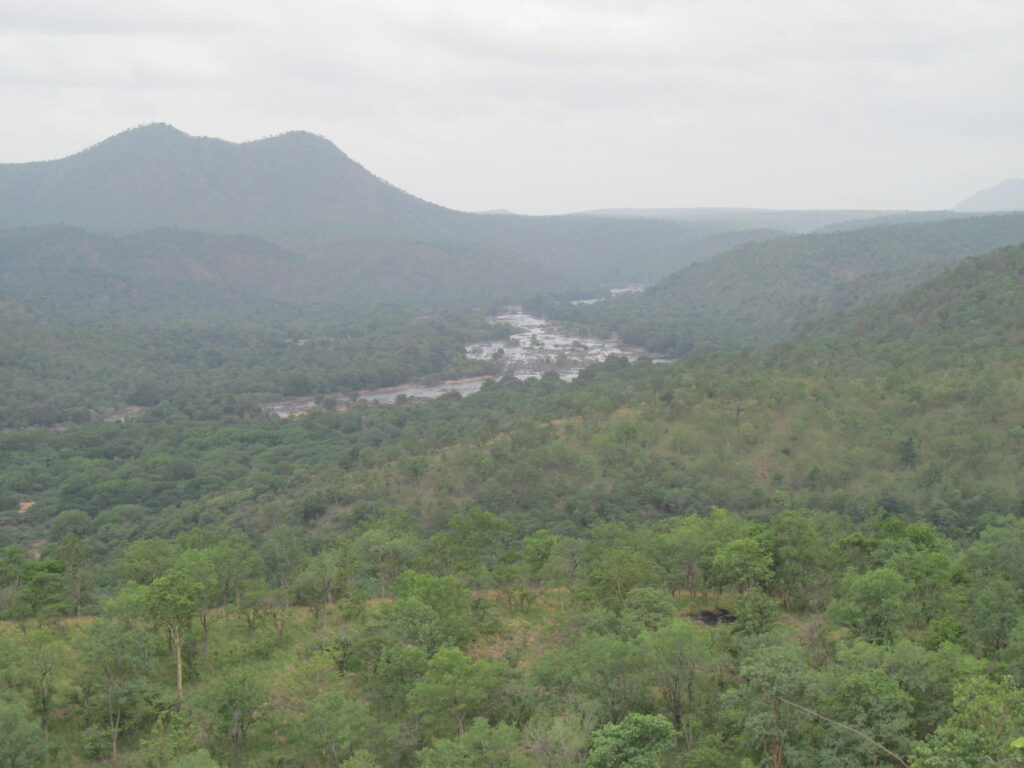
India is a very underexplored part of the world when it comes to Pleistocene research. This is quite unfortunate because it was a really interesting place. During the earlier part of the Pleistocene, a giraffid named Sivatherium and a proboscidean named Deinotherium roamed India-two of the largest land mammal to have walked the earth. The Acheulean stone-tool industry, associated with Homo erectus, seems to have survived the longest in the subcontinent3.
During the Late Pleistocene, a number of extinct animals lived in India in addition to many of the iconic species that are still extant but endangered like Asian elephants and Indian rhinos. Among them were a small hippo(Hexaprotodon), a horse(Equus namadicus), and two extinct species of proboscidean-Palaeoloxodon namadicus and Stegodon namadicus 4. Palaeoloxodon namadicus was yet another giant-a possible contender for largest land mammal to have existed. There was also a subspecies of aurochs, later domesticated into the zebu. Even the common ostrich, normally associated with Africa, was present!
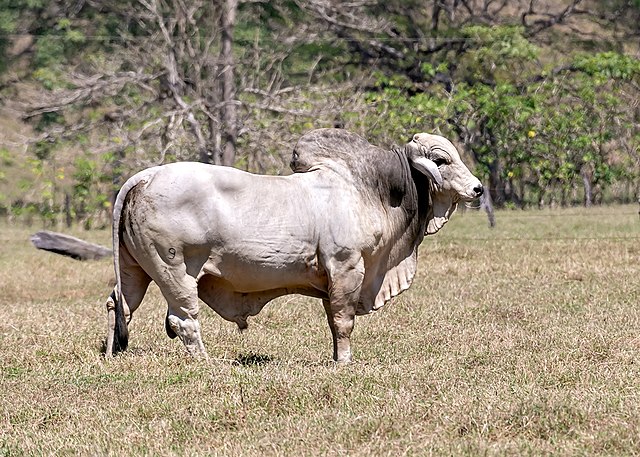
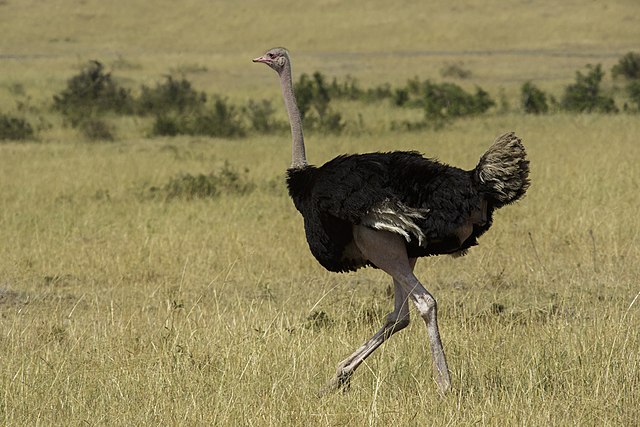
The magnitude of Late Pleistocene extinctions in India was fairly low4. This might cause people to assume that Holocene India is a place where megafaunal communities were “intact” until recently and overlook the possibility that natural environments in Pleistocene India were more strongly shaped by animals. However, I wondered if this assumption is wrong and tried to investigate by seeing if there were any differences between vegetation in India during the Holocene and previous interglacials that might point to animals having a greater impact on their environments back then.
Sadly, I did not find much pollen data from different regions going that far back, but what little I did find is very intriguing-assuming my interpretation is correct and reflects broader trends. I read two studies that analyzed pollen data from marine cores. The first, from western India, shows that at no point during the past 200 thousand years was arboreal(tree) pollen as high as it was during the last 15 thousand years5. This is despite conditions in India being overall slightly wetter during the last interglacial, along with similar CO2 to the pre-industrial era6.
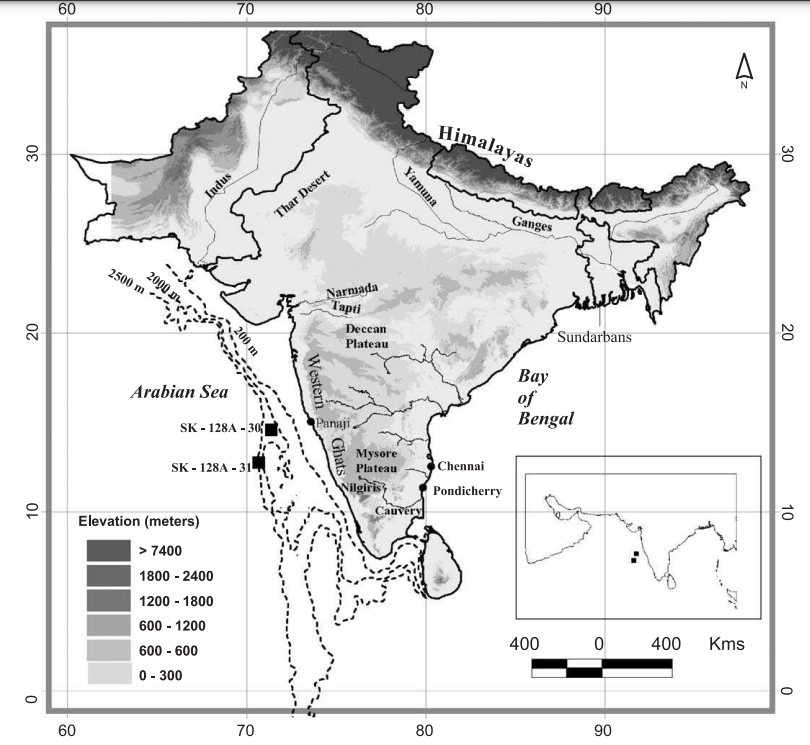
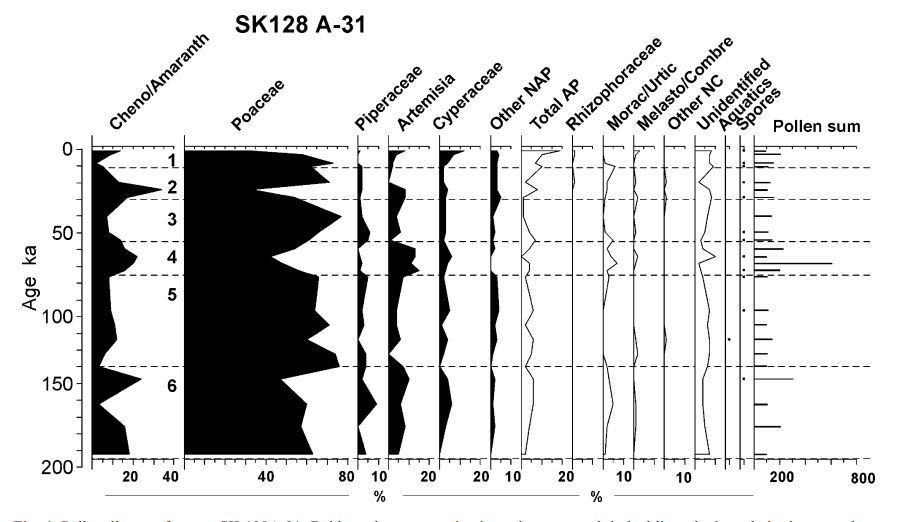
The second study was from eastern India, and the watershed associated with the core contents is generally quite moist6. They compared the last interglacial with the early-mid Holocene. It shows that wet evergreen taxa were clearly more abundant in the last interglacial and there were slightly fewer xerophytes(very dry-adapted plants), indicating wetter conditions. Yet, the graminoid/grass proportion was also slightly higher in the last interglacial. There was also a tiny bit more deciduous taxa back then, but they unfortunately were not able to separate dry and moist deciduous forests.
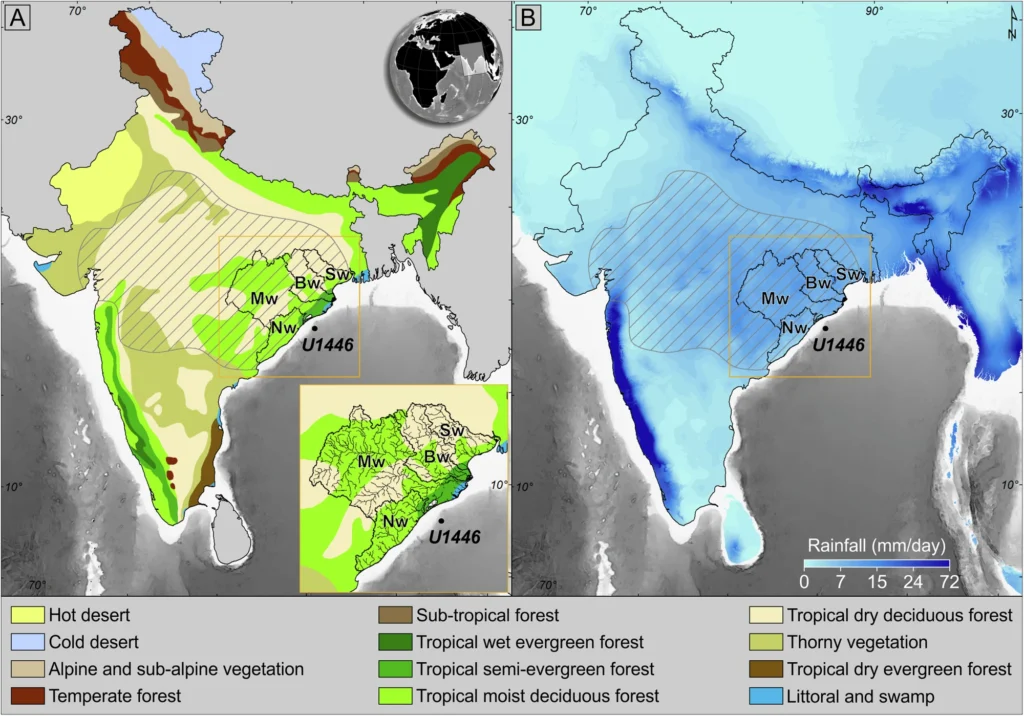
biome distribution in India. Right: Precipitation
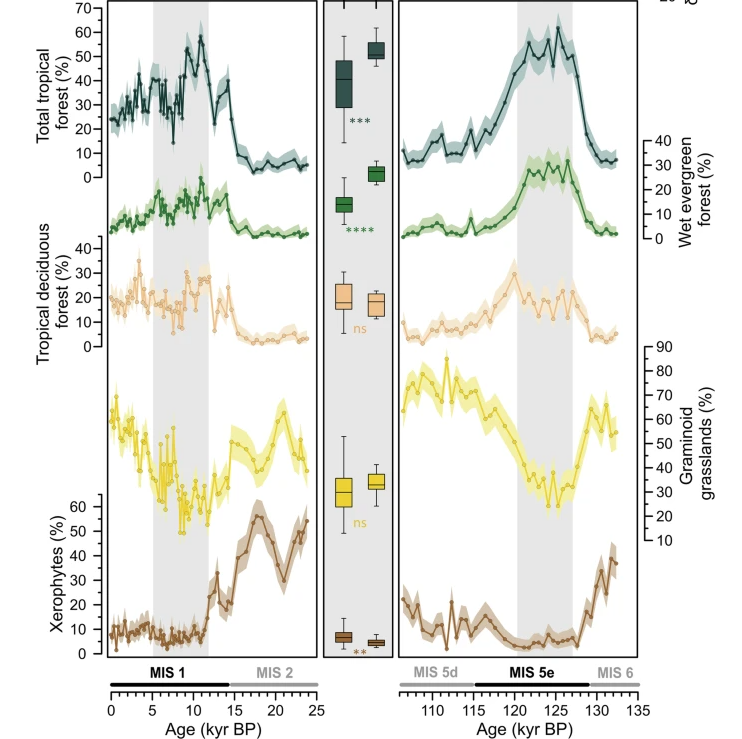
Results from both studies may be consistent with a scenario where large herbivores were suppressing trees-likely mainly dry deciduous types-by trampling, feeding on, and felling them. There is evidence that large herbivores in Africa keep the savannah regions less woody and promote grass growth by doing this7 8. The second pollen study shows that the ratio of wet evergreen forest to total tropical forest was higher for the last interglacial than the Holocene, showing that deciduous elements formed a smaller component of total trees. Part of this is probably due to climate alone, but it is surprising that grasses were more common too.
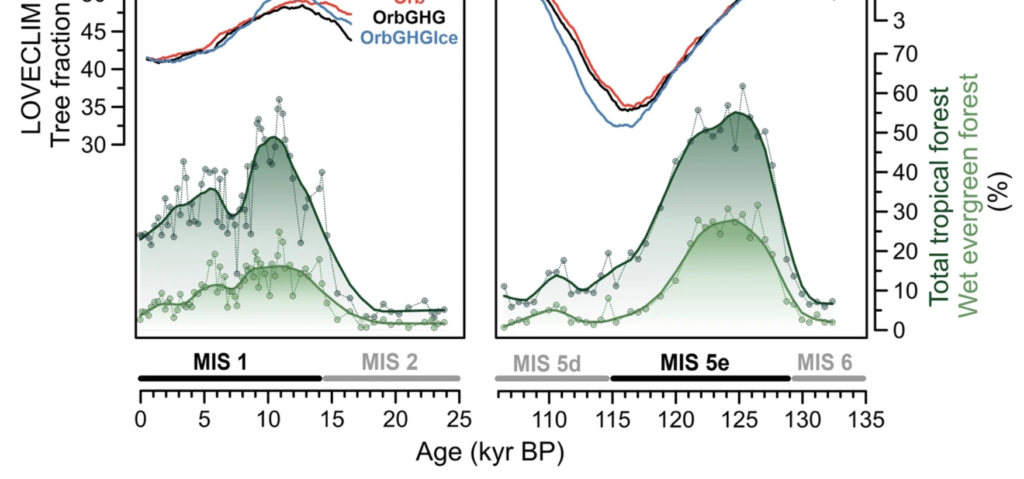
In Africa, evergreen trees in rainforests like the Congo are spared the worst effects of herbivory as they grow tall and thick compared to drier savannah types and form a closed canopy that shuts out many big herbivore species. If a similar dynamic was taking place in this region during the last interglacial, this could partly explain why the proportions for both graminoids and wet evergreen forest were higher back then than now-the dry forest regions had sparser trees and more grasses.
Extrapolating from these results, it is possible that the dry forest of much of Central India during interglacials was actually savannah similar to what we see in Africa. This might be due to the disproportionate effects of one or two extinct herbivores, perhaps combined with greater densities of still-extant herbivores. Palaeoloxodon namadicus, as a behemoth weighing 16 tonnes by conservative estimates9, might have had greater impacts than the surviving Asian elephant or any living herbivore for that matter. It was a grazer10 but the destructive behavior of elephants towards trees cannot be explained by feeding habits alone11.
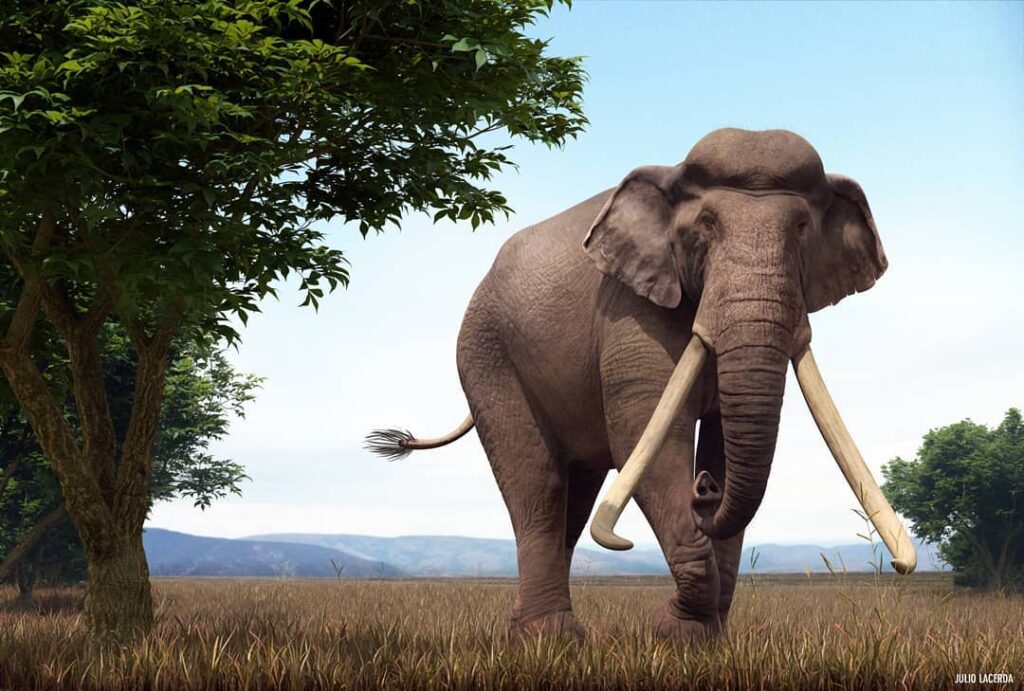
Its extinction is estimated to have taken place somewhere between the LGM and the terminal Pleistocene4. The effects of animal losses were probably not felt fully until interglacial conditions set in with strong monsoons and high CO2 concentrations, when there were not enough-or not enough of particular types of-large herbivores to mitigate dry forest expansion.
This is of course just my interpretation of the admittedly very scant data we have so far, so I would caution against taking it too seriously if or until we have more studies to back this up. I really do hope there is more research on this topic, however. The first study clearly shows that arboreal pollen was lower in the past, but the watersheds associated with the U1446 core in the second study are unusually wet by Indian standards and contain a relatively low proportion of dry forest. There are probably better regions to investigate how megafauna might have influenced such ecosystems in the past.
Pollen cores from different parts of India stretching back to the last or even older interglacials would be helpful, especially if we could analyze them for changes in dung fungi concentration over time to see what role herbivore density played. The potential role of fire would also need to be accounted for, as fire frequency for the Holocene might have been different than other interglacials. Humans are known to have burned forests everywhere they settled, so this could be a confounder.
My money is on the possibility that Indian megafauna of the past did exert strong controls on India’s vegetation.
References
1. Doughty, C. E., Faurby, S., & Svenning, J.-C. (2015). The impact of the megafauna extinctions on savanna woody cover in South America. Ecography, 39(2), 213–222. https://doi.org/10.1111/ecog.01593
2. Pearce, E. A., Mazier, F., Normand, S., Fyfe, R., Andrieu, V., C.C. Bakels, Balwierz, Z., Krzysztof Bińka, Boreham, S., Borisova, O., Broström, A., Jacques‐Louis de Beaulieu, Gao, C., Penélope González-Sampériz, Wojciech Granoszewski, Hrynowiecka, A., Piotr Kołaczek, Petr Kuneš, Magri, D., & Malkiewicz, M. (2023). Substantial light woodland and open vegetation characterized the temperate forest biome before Homo sapiens. Science Advances, 9(45). https://doi.org/10.1126/sciadv.adi9135
3. Blinkhorn, J., & Petraglia, M. D. (2017). Environments and Cultural Change in the Indian Subcontinent: Implications for the Dispersal of Homo sapiens in the Late Pleistocene. Current Anthropology, 58(S17), S463–S479. https://doi.org/10.1086/693462
4. A.M. Jukar, Lyons, S. K., Wagner, P. J., & M.D. Uhen. (2020). Late Quaternary extinctions in the Indian Subcontinent. Palaeogeography Palaeoclimatology Palaeoecology, 562, 110137–110137. https://doi.org/10.1016/j.palaeo.2020.110137
5. Prabhu, C. N., Shankar, R., K. Anupama, M. Taieb, R. Bonnefille, Vidal, L., & Prasad, S. (2004). A 200-ka pollen and oxygen-isotopic record from two sediment cores from the eastern Arabian Sea. Palaeogeography Palaeoclimatology Palaeoecology, 214(4), 309–321. https://doi.org/10.1016/j.palaeo.2004.07.027
6. Clément, C., Martinez, P., Yin, Q., Clemens, S., Thirumalai, K., Prasad, S., Anupama, K., Su, Q., Lyu, A., Grémare, A., & Desprat, S. (2024). Greening of India and revival of the South Asian summer monsoon in a warmer world. Communications Earth & Environment, 5(1). https://doi.org/10.1038/s43247-024-01781-1
7. Asner, G. P., Levick, S. R., Kennedy-Bowdoin, T., Knapp, D. E., Emerson, R., Jacobson, J., Colgan, M. S., & Martin, R. E. (2009). Large-scale impacts of herbivores on the structural diversity of African savannas. Proceedings of the National Academy of Sciences, 106(12), 4947–4952. https://doi.org/10.1073/pnas.0810637106
8. Staver, A. C., Bond, W. J., Stock, W. D., van Rensburg, S. J., & Waldram, M. S. (2009). Browsing and fire interact to suppress tree density in an African savanna. Ecological Applications, 19(7), 1909–1919. https://doi.org/10.1890/08-1907.1
9. Biswas, D. S., Chang, C.-H., & Tsai, C.-H. (2024). Land of the giants: Body mass estimates of Palaeoloxodon from the Pleistocene of Taiwan. Quaternary Science Reviews, 336, 108761. https://doi.org/10.1016/j.quascirev.2024.108761
10. Patnaik, R., Singh, N. P., Paul, D., & Sukumar, R. (2019). Dietary and habitat shifts in relation to climate of Neogene-Quaternary proboscideans and associated mammals of the Indian subcontinent. Quaternary Science Reviews, 224, 105968. https://doi.org/10.1016/j.quascirev.2019.105968
11. Midgley, J. J., Balfour, D., & Kerley, G. I. (2005). Why do elephants damage savanna trees? South African Journal of Science, 101(5), 213–215.